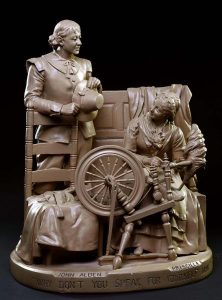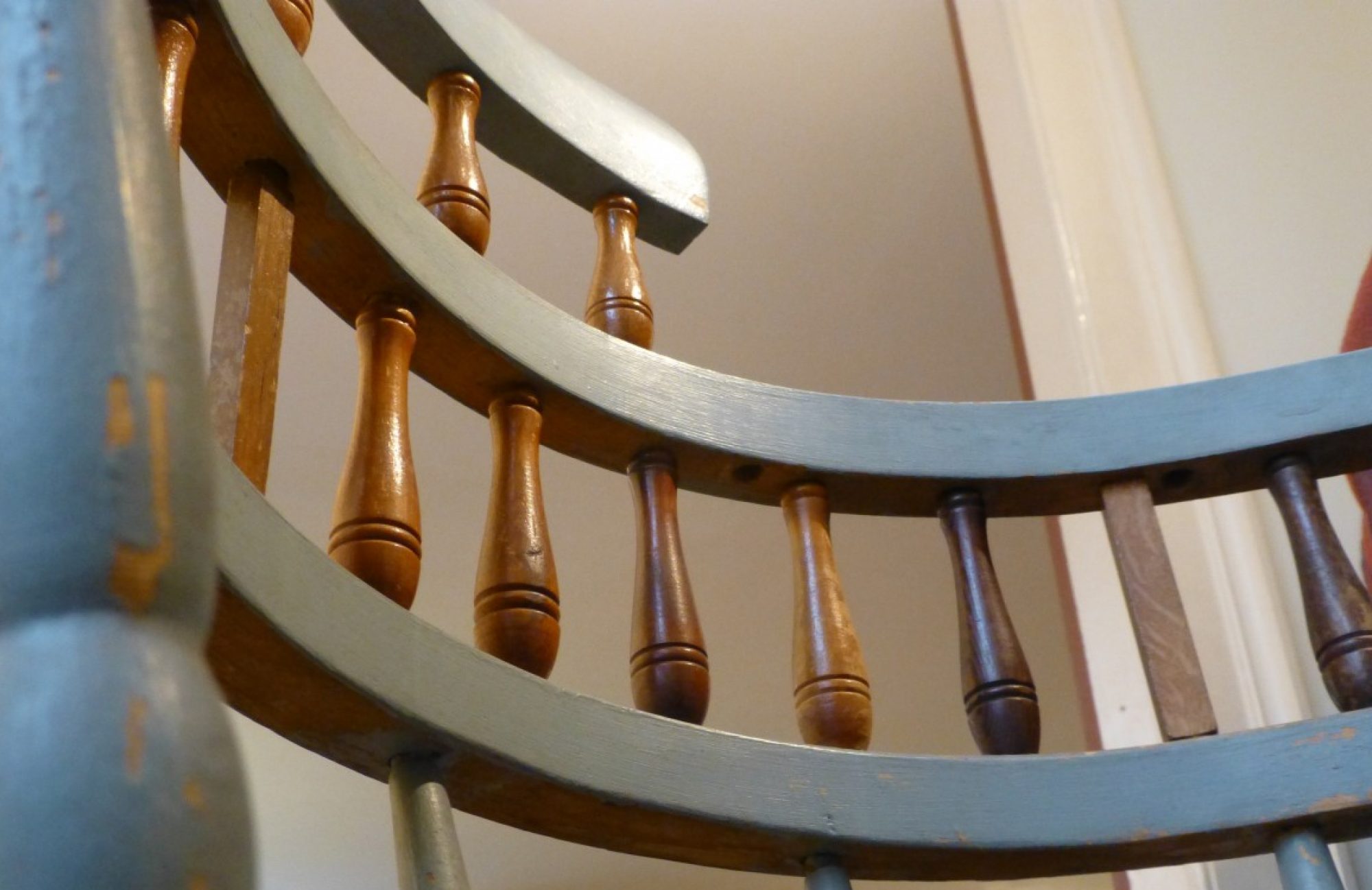For the first spindle of his relic chair, Henry Sheldon chose to use wood from the William Alden House in Boston, Massachusetts. Sheldon records the house as being built in 1660 on the corner of Sudbury and Alden Street, before being torn down two centuries later in 1860. The house’s presumed establishment in 1660 makes it the oldest sample in Sheldon’s chair. This longevity is likely responsible for its placement as the first of the 24 spindles, which are generally arranged in chronological order from oldest to newest. In his journal, Sheldon notes that the wood for the spindle was taken from one of the house’s oak mantle beams; however, he makes no further comments on the donor of the wood or how or why he acquired it.(1) To determine the significance of the William Alden house as a component of Sheldon’s relic chair, one must closely examine the genealogical history of the Alden family.
William Alden, born on September 10, 1669, was the tenth of eleven children born to parents John Alden and Elizabeth Phillips, and one of 8 boys. However, William was only one of five of these children to live past the age of five.(2) Upon John Alden’s death in 1702, he willed his estate in five parts to his surviving children and their families, one piece of this estate going to William, who was at this point John’s second eldest remaining son.(3) While Henry Sheldon’s records cite William Alden’s house as being built in 1660, various family records report the house as built in 1653, while dendrochronology testing of the houses beams date its construction as closer to the year 1700.(4)
William Alden was married to Mary Drury on May 10, 1691, at the age of 21. The two remained married until William’s death, and together bore seven children over the span of eighteen years. William made his living as an accomplished sailor based out of the Boston area. He was involved in a number of voyages throughout the late 17th and early 18th centuries. Notably, William was a master on the ships Katharine and Content, which both sailed out of his home port of Boston in May 1698, and November 1704,respectively. Alden also piloted the ship Chester on an expedition to Jamaica’s Port Royal in 1710.(5) While it is unclear the purpose of these expeditions, it seems likely that William’s ships followed various trade routes to and from Boston. There is little information available surrounding the remainder of William Alden’s adult and professional life. He passed away in February 1729 at the age of 60.(6)

Due to the lack of documentation regarding William Alden’s personal life, it is possible that much of the significance of the William Alden house, and its usage in Sheldon’s relic chair, relates to the story of William’s famous grandparents, John and Priscilla Alden. The love story between John Alden and Priscilla Mullins gained widespread fame following their voyage as Pilgrims on the Mayflower. The famous story is recounted in Henry Wadsworth Longfellow’s 1858 poem, “The Courtship of Miles Standish.” The poem is based on historical events, and dramatizes the story of John’s unlikely proposal to Priscilla. Longfellow tells that after the first winter following the Pilgrims’ arrival at Plymouth, Captain Miles Standish called John Alden to inform him that Standish’s wife had died, and he wished to remarry. Standish had chosen Priscilla Mullins as the woman he would like to marry, and he asked Alden to propose to her on Standish’s behalf. Alden was troubled by this request, but obeyed nonetheless. When Alden proposed to Mullins in Standish’s name, Mullins sensed Alden’s true feelings, and replied, “Why don’t you speak for yourself, John?”(7) The two were married soon after in 1622.(8) Besides Longfellow’s poem, this story was further popularized by John Rogers’s mass-produced statuette entitled Why Don’t You Speak for Yourself, John?, which depicts Alden proposing to Mullins while she works at her spinning wheel.(9)
While it is difficult to conclusively link John and William Alden to Middlebury, their impact on New England is well documented in the works of both Longfellow and Rogers. The historical coverage of the William Alden House is likely overshadowed by the prominence of the neighboring John Alden House, which was once home to John and Priscilla Alden. The house still stands today as a museum shortly outside of Boston and is thought to have possibly used materials from the William Alden house in its construction (McCarthy).(10) Considering this potential link to John Alden’s historic site, the William Alden house secures greater historical weight on a broad scale, and gains additional validity in its selection as part of Sheldon’s relic chair.
– Peter Martin ’19
References:
1. HL Sheldon Papers, Vol 19, Collection of the Henry Sheldon Museum, Middlebury, Vermont.
2. “User Home Page Book: The Ancestors of Robert Cutler Elwell: Ahnentafel Report of Robert Cutler Elwell.” Genealogy.com, www.genealogy.com/ftm/e/l/w/Robert-C-Elwell-MA/BOOK-0001/0002-0054.html.
3. Ebenezer Alden, Memorial of the Descendants of the Hon. John Alden (Randolph, MA: Samuel P. Brown, 1867), pp. 3.
4. Tom McCarthy, Erika K. Martin Seibert; Patty Henry, Edward L. Bell, Betsy Friedberg; Phil Bergen, “National Historic Landmark Nomination: John and Priscilla Alden Family Sites / Alden House (DUX.38) and Original Alden Homestead Site (aka Alden I Site, DUX-HA-3)” March 2007. National Park Service.
5. Lucy Mary Kellogg, et al, Mayflower Families Through Five Generations: Part 1: Family of John Alden (Plymouth, MA: General Society of Mayflower Descendants, 1975), 93.
6. Alden, 7.
7. Henry Wadsworth Longfellow, “The Courtship of Miles Standish,” in The Courtship of Miles Standish and Other Poems (Boston: Ticknor and Fields, 1858). https://archive.org/details/courtshipofmiles00long10
8. Genealogy.com
9. Rogers, John. “Why Don’t You Speak for Yourself, John?” Smithsonian.com, americanart.si.edu/artwork/why-dont-you-speak-yourself-john-21162.
10. National Park Service 2014
